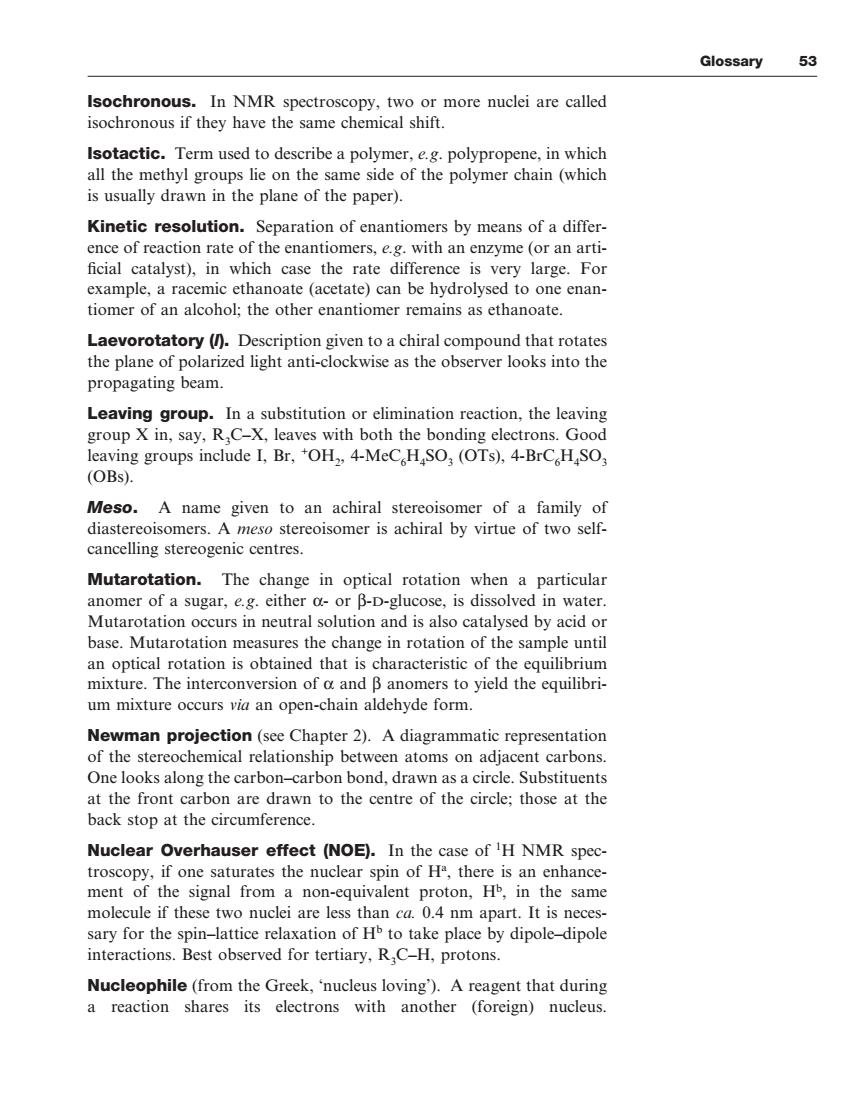正在加载图片...

Glossary 53 Isochronous.In NMR spectroscopy,two or more nuclei are called isochronous if they have the same chemical shift Isotactic.Term used to describe a polymer,e.g.polypropene,in which all the methyl groups lie on the same side of the polymer chain(which is usually drawn in the plane of the paper) Kinetic resolution.Separation of enantiomers by means of a differ. ence of reaction rate of the enantiomers,e.g.with an enzyme (or an arti- ficial catalyst),in which case the rate difference is very large.For example,a racemic ethanoate (acetate)can be hydrolysed to one enan. tiome of an alcohol;the other enantiomer remains as ethanoate Laevorotatory ()Description given to a chiral compound that rotates the plane of polarized light anti-clockwise as the observer looks into the propagating beam. Leaving group.In a substitution or elimination reaction,the leaving group X in,say,R,C-X,leaves with both the bonding electrons.Good leaving groups include I,Br,*OH,,4-MeC H SO (OTs),4-BrC H SO (OBs). Meso.A name given to an achiral stereoiso mer of a family of diastereoisomers.A meso stereoisomer is achiral by virtue of two self cancelling stereogenic centres. Mutarotation.The change in optical rotation when a particular anomer of a sugar,e.g.either a-or B-D-glucose.is dissolved in water. Mutarotation occurs in neutral solution and is also catalysed by acid or base.Mutarotation measures the change in rotation of the sample unti an optical rotation is obtained that is characteristic of the equilibrium mixture.The interconversion of a and B anomers to yield the equilibri- um mixture occurs via an open-chain aldehyde form. Newman projection(see Chapter 2).A diagrammatic representation of the stereochemical relationship between atoms on adjacent carbons One looks along the carbon-carbon bond.drawn as a circle.Substituents at the front carbon are drawn to the centre of the circle;those at the back stop at the circumference. Nuclear Overhauser effect (NOE).In the case of H NMR spec troscopy,if one saturates the nuclear spin of H",there is an enhance- ment of the signal from a non-equivalent proton,H,in the same molecule if these two nuclei are less than ca.0.4 nm apart.It is neces- sary for the spin-lattice relaxation of Hb to take place by dipole-dipole interactions.Best observed for tertiary,RC-H,protons Nucleophile(from the Greek,'nucleus loving).A reagent that during a reaction shares its electrons with another (foreign)nucleus. Isochronous. In NMR spectroscopy, two or more nuclei are called isochronous if they have the same chemical shift. Isotactic. Term used to describe a polymer, e.g. polypropene, in which all the methyl groups lie on the same side of the polymer chain (which is usually drawn in the plane of the paper). Kinetic resolution. Separation of enantiomers by means of a difference of reaction rate of the enantiomers, e.g. with an enzyme (or an arti- ficial catalyst), in which case the rate difference is very large. For example, a racemic ethanoate (acetate) can be hydrolysed to one enantiomer of an alcohol; the other enantiomer remains as ethanoate. Laevorotatory (l). Description given to a chiral compound that rotates the plane of polarized light anti-clockwise as the observer looks into the propagating beam. Leaving group. In a substitution or elimination reaction, the leaving group X in, say, R3 C–X, leaves with both the bonding electrons. Good leaving groups include I, Br, +OH2 , 4-MeC6 H4 SO3 (OTs), 4-BrC6 H4 SO3 (OBs). Meso. A name given to an achiral stereoisomer of a family of diastereoisomers. A meso stereoisomer is achiral by virtue of two selfcancelling stereogenic centres. Mutarotation. The change in optical rotation when a particular anomer of a sugar, e.g. either α- or β-D-glucose, is dissolved in water. Mutarotation occurs in neutral solution and is also catalysed by acid or base. Mutarotation measures the change in rotation of the sample until an optical rotation is obtained that is characteristic of the equilibrium mixture. The interconversion of α and β anomers to yield the equilibrium mixture occurs via an open-chain aldehyde form. Newman projection (see Chapter 2). A diagrammatic representation of the stereochemical relationship between atoms on adjacent carbons. One looks along the carbon–carbon bond, drawn as a circle. Substituents at the front carbon are drawn to the centre of the circle; those at the back stop at the circumference. Nuclear Overhauser effect (NOE). In the case of 1 H NMR spectroscopy, if one saturates the nuclear spin of Ha , there is an enhancement of the signal from a non-equivalent proton, Hb, in the same molecule if these two nuclei are less than ca. 0.4 nm apart. It is necessary for the spin–lattice relaxation of Hb to take place by dipole–dipole interactions. Best observed for tertiary, R3 C–H, protons. Nucleophile (from the Greek, ‘nucleus loving’). A reagent that during a reaction shares its electrons with another (foreign) nucleus. Glossary 53